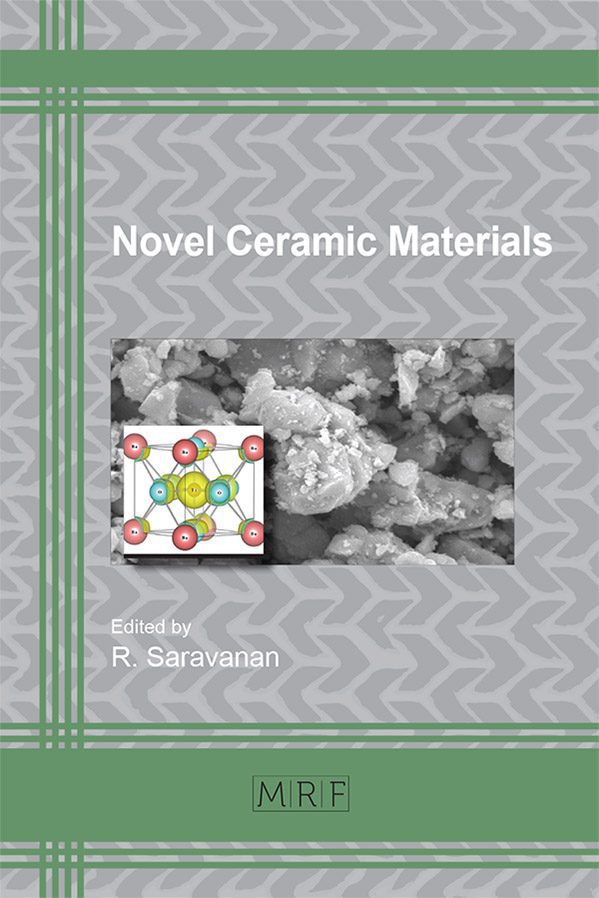Inter Bond Experimental Electron Density in Magnesium Ferrite Ceramic (MgFe2O4) Through XRD
M.J. Viswanath, M. Aysha kani, S.V. Meenakshi, R. Saravanan
The magnesium ferrite (MgFe2O4) sample is prepared with the solid state reaction method. It was characterized by Powder-XRD, UV-visible and SEM. The average crystallite sizes are calculated by the Debye Scherrer’s formula in the range of micrometers. From the XRD data the electron density is evaluated using the MEM (Maximum Entropy Method) analysis. UV- visible spectroscopy was used to calculate the band gap value of the material and the particle size is measured through SEM.
Keywords
Spinel Cubic, Electron Density, Bonding Nature, MEM, Direct Band Gap, Rietveld Refinement, SEM & UV-Visible
Published online 6/1/2016, 13 pages
DOI: 10.21741/9781945291036-3
Part of Novel Ceramic Materials
References
[1] D. L. Leslie-Pelecky, R. D. Rieke: Chem. Magnetic Properties of Nanostructured Materials 8 (1996), 1770-1783.
[2] R. J. Willey, P. Noirclerc & G. Busca: Chem. Ningbo Institute of Materials Technology and Engineering (NIMTE). Commun. 123 (1993), 1-16.
[3] V. Šepelák, D. Baabe, D. Mienert, F. J. Litterst, K. D. Becker, “Enhanced Magnetisation in Nanocrystalline High-Energy Milled MgFe2O4”, Srcipta Materialia 48 (2003) 961-966
http://dx.doi.org/10.1016/S1359-6462(02)00600-0
[4] V. Šepelák, M. Menzel, K. D. Becker, F. Krumeich, “Mechanochemical Reduction of Magnesium Ferrite”, J. Phys. Chem. B 106 (2002) 6672-6678
http://dx.doi.org/10.1021/jp020270z
[5] Daliya S. Mathew, Ruey-Shin Juang: Chemical Engineering Journal, 129 (2007), 51-65
http://dx.doi.org/10.1016/j.cej.2006.11.001
[6] B.D. Cullity: Elements of X-ray diffraction. Addison-Wesley series in Metallurgy & materials, (1978)
[7] H.M. Rietveld: J. Appl. Crystallogr. 2 (1969) 65
http://dx.doi.org/10.1107/S0021889869006558
[8] V. Petricek, M. Dus ek, L. Palatinus, in: JANA 2000, The Crystallographic Computing System, Institute of Physics, Academy of Sciences of the Czech Republic, Praha, 2000.
[9] A.D. Ruben, I. Fujio: Super-fast Program PRIMA for the Maximum Entropy Method, Advanced materials Laboratory, National Institute for Materials Science, Ibaraki, Japan (2004).
[10] F. Izumi, R.A. Dilanian: Recent Research Developments in Physics, Part II, 3, Transworld, Research Network, Trivandrum, 2002, pp. 699-726.
[11] K. Mooma, F. Izumi: J. Appl. Crystallogr. 41 (2008) 653.
http://dx.doi.org/10.1107/S0021889808012016
[12] D.M. Collins: Nature 49 (1982) 298.
[13] S.O Kasap: Electrical Engineering Materials and Devices. Irwin (1997) Chapters 5.7
[14] B.Streetman: Solid-State Electronic Devices. Prentice-Hall. (1995), Chapter 4.1
[15] O. Stenzel: The Physics of Thin Film Optical Spectra: An Introduction. Springer. (2005),214.
[16] L.B. Fraigi, D.G. Lamas and N.E. Walsoe de Reca, Material Letters 47 (2001) 262-266
http://dx.doi.org/10.1016/S0167-577X(00)00246-9
[17] R. Saravanan: GRAIN software available at http://www.saraxraygroup.net/
“>































